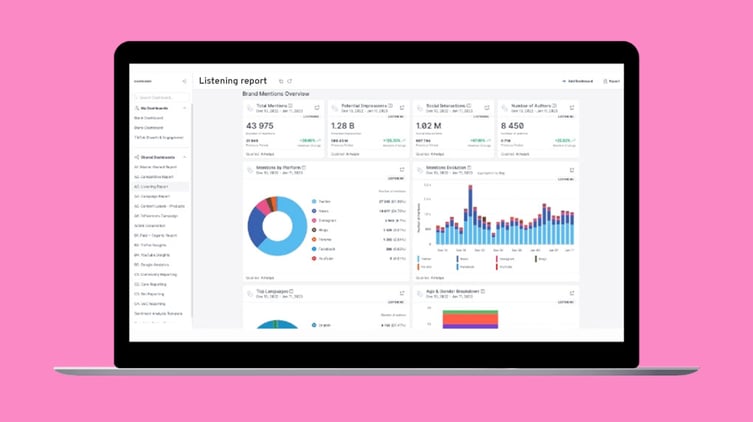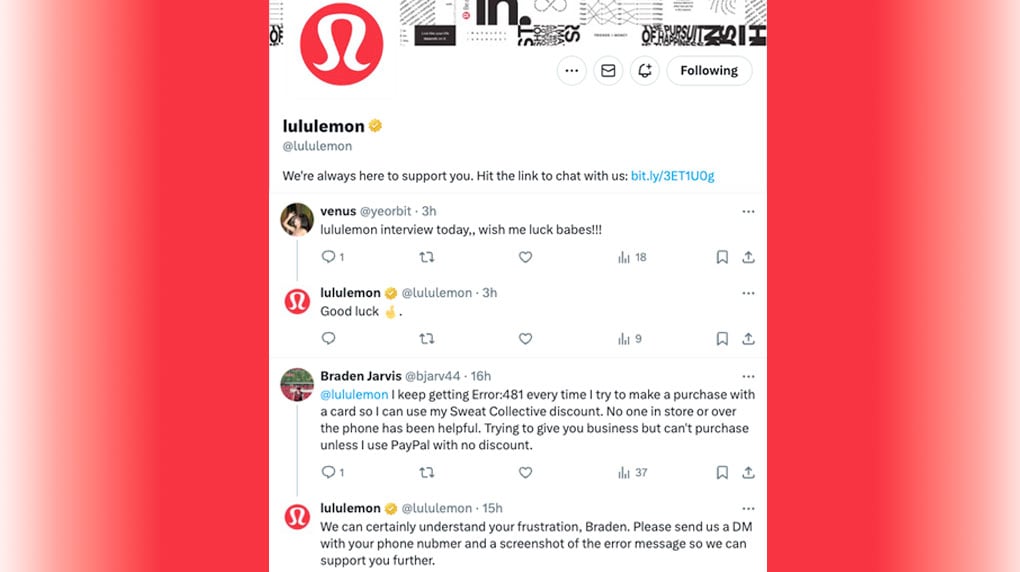Whether you initiate it or not, your business is going to develop a brand reputation. If you let it happen organically, you’re leaving that reputation up to chance. By intentionally crafting your brand identity and branding strategy, you can make it work for you. You’ll be able to shape your customer’s perception of your brand, better your ability to recruit talent, and use it to gain a tangible ROI.
Let’s explore the intricacies of digital branding. We’ll cover:
Digital branding has come a long way since the first clickable web banner ad in 1993 (which was pre-Google, by the way). Digital branding evolved alongside technology, coming leaps and bounds with the introduction of smartphones and social media platforms.
In our digital age, consumers have direct access to brands online. They expect more than just products or services. Instead, they want a two-way, instant, and personalized interaction. And future trends show these expectations only growing. AI poses a huge opportunity for automation. However, the more automated digital interactions become, the more customers crave genuine human connection. Brands who can find the sweet spot between the two will do very, very well.
But despite the years and market advances, one thing has remained the same. Whether you're a global giant like Nike or a local boutique, you share the same digital platforms and compete for the same attention.
This underscores the importance of staying relevant, adapting to trends, and strategizing how you show up in the online marketplace.
Digital brand management is how you control the way the world perceives you. If you want to shape your audience’s perception, you need to be specific with how you present your brand online and tell your brand story.
Digital brand management is the process of curating your online presence using tactics and digital channels, like creating engaging content and then publishing it at the right time, in the right place, to the right people.
Here are six best practices for managing a brand’s digital presence.
If you don’t have a clear idea of your brand’s identity, then you’re going to show up looking scattered. You need to define your brand’s mission, vision, and values. Know your unique selling proposition and have an understanding of your brand’s personality. Then, put everything into a brand guide and circulate it throughout your organization.

Everyone in your organization should be able to sum up who your brand is in a couple of sentences. This is a great litmus test for if your brand is well-defined and communicated properly throughout your company.
Your website should be ground zero for your brand. Give your site a brand audit to be sure it’s communicating what you want to potential customers. Ask yourself if it reflects your brand identity, and define how it does so on each of your pages.
Search engine optimization (SEO) is essential for improving your brand's visibility in search engine results.
Pro tip: Make use of professional tools like Semrush, MOZ, and Ahrefs.
Conduct keyword research to understand what your target audience is searching for, and optimize your website and content accordingly. This includes optimizing meta tags and headings and creating high-quality, relevant content. You can take it one step further and start optimizing your social media content with your keywords in mind.
Everything you put out onto the internet should be done with intention. Ensure your paid and organic content marketing strategy accurately reflects your brand voice and visuals. Oh, and of course, you’re going to want to publish content that’s either valuable to or engaging for your target audience.
What’s the first thing you do when deciding on a new product or service? If you’re like many of your customers, you read the reviews.
Take a look at your customer reviews, comments, or mentions. Do they accurately reflect your brand values? If you say you value accountability but don’t own up to negative reviews, it might be time to ask why. If any negative reviews have heavily impacted the brand, it might be a reason to rebrand.

You don’t have to do the legwork yourself, either. You can use tools like Brandwatch to crawl the internet looking for mentions of your brand. You can also use social listening tools to keep an eye on your competitors and trending industry news. Our partner, Hootsuite, offers tons of automation tools to help with this.
Your data and analytics tools give you a look into what’s working and what’s not. Metrics like website traffic, conversion rates, social media engagement, and email open rates all tell a story about how you're presenting your brand online. Use these insights to adjust your digital brand management.
What exactly is a digital brand strategy?
A digital brand strategy is a long-term plan and framework used to guide how a brand will be positioned in the online market. It also covers:
A digital brand strategy sets the direction for all online brand-related activities and decisions, including marketing, messaging, and design. Brand development is the tactical execution of the brand strategy. To be able to execute a brand strategy, you must first have a brand strategy.
As a reminder, here’s how to craft a digital brand strategy in five simple steps:
Start off by defining who your brand is and why it operates (besides making money).
Map out your brand's mission, vision, and values. Then, craft your brand persona; define the brand voice you’re going to use, your brand’s look and feel, and any other identifying characteristics you can think of.
Branding development tactic: Once you’ve defined your brand identity and purpose, create a brand book you can circulate to new hires and your existing team.

Step 2 may influence Step 1 and vice versa, so you may want to do these steps at the same time.
Clearly define your target audience's demographics, preferences, behaviors, and online habits. Understand their pain points and needs.
Branding development tactic: Conduct thorough market research to gain insight into who your target audience is. Create an empathy map or audience personas.
You don’t want to rehash what everyone else is doing, and you also don’t want to miss out on effective strategies. So, take a look at what your competitors are up to and analyze their digital strategies. You’ll determine what works for them and where the market gaps are that you can exploit.
Branding development tactic: Perform a SWOT analysis.
You’re going to want to define SMART (specific, measurable, achievable, relevant, and time-bound) objectives for your strategy. Make sure these objectives align with your overall business goals.
Once your goals are defined, map out the tactics you’ll need to implement to achieve them. This could include the channels or platforms you’ll need to use, the digital tools you need to implement, or the content you’ll need to leverage.
Branding development tactic: Take a look at your overall business goals and think of ways your brand strategy can deliver on those goals. Then, write your objectives using the SMART goal parameters.
Part of your brand strategy should include promoting your brand using content. While your content strategy is technically part of your brand strategy, you’ll likely need to develop it separately. An in-depth content strategy can include a ton of moving parts, tools, and platforms.
Your content strategy will likely include:
Stay tuned as we will discuss these bullet points in depth in the next section!
Branding development tactic: Dedicate time and budget to developing a content strategy.
A digital growth strategy will use both your brand strategy and your content strategy in tandem to grow your brand. Here are four strategies for leveraging digital channels for brand growth:
Develop a comprehensive social media listening strategy to gain insights into industry trends, competitor strategies, and customer sentiment. Use this data to dictate the direction of your social media content.
Once you’ve created high-quality, relevant content, supplement your organic content with paid. Use advanced social media advertising features like lookalike audiences, retargeting, and dynamic product ads to reach highly qualified prospects.
See how Roller Rabbit leveraged a paid media strategy to boost conversion rates by 176%.
First, invest in technical SEO, including server optimization, structured data, and website architecture improvements. Then, develop a comprehensive content cluster strategy to dominate search results for key topics. To do so, you can leverage machine learning tools like Semrush.
You can segment your email list based on user behavior and preferences. Then, implement drip email campaigns with personalized content and product recommendations delivered at strategic places in your customer’s user journey. Be sure to A/B test email subject lines, content, and send times.
See how MadeGood used an email marketing campaign to boost eCommerce revenue by 316%.

Share your high-quality content on various digital platforms, such as guest posting on relevant blogs, publishing articles on industry websites, and submitting your content to content aggregators. This digital growth strategy can help you reach new audiences and establish your brand as an industry authority.
You’ve likely already realized how intertwined digital marketing strategies are. Digital strategies complement traditional branding efforts, too. Every piece of branded content your audience interacts with is connected in their mind, whether that’s a billboard or an Instagram post.
Integrating your digital and traditional marketing efforts isn’t just advantageous anymore; it’s expected. Your audience expects consistency in all of your branding.
Challenge: Social media and search engine algorithms frequently change, affecting organic reach and ad performance.
Solution: Stay agile and diversify your digital channels. Pay attention to algorithm updates such as Google's Search Status Dashboard. Then, adjust your strategy accordingly. Focus on creating content that encourages engagement and authentic interactions.
Remember, these algorithm updates intend to provide valuable people-first content, so put your audiences' needs at the core of your content and SEO strategy, and you’ll naturally adapt to the algorithm.
Challenge: Measuring the return on investment (ROI) of digital branding efforts can be complex, especially when attributing results to specific channels.
Solution: Implement advanced analytics tools and attribution models to track ROI accurately. Set clear KPIs aligned with your business objectives, and regularly analyze the data to optimize campaigns.
Everything is connected, so a win on one channel is a win for all efforts. On this note, remember to un-silo your data and look at your data holistically. For example, Meta just reports on the Meta platforms, so see how Meta traffic behaves on your website on Google Analytics. You can leverage tools like Supermetrics or Looker Studio to pull in data from different sources and view them as live dashboards.
Challenge: Digital options are abundant, so building and retaining brand loyalty can be tough.
Solution: Create personalized customer experiences, reward loyal customers, and don’t slack on community engagement or customer experience. Don’t forget to be social on your social network.

Digital branding doesn't exist in isolation; it's integral to overall brand development. Your digital strategy should work in tandem with your other branding efforts, as your customer no longer separates the online experience from the offline world.
Use the advice above to integrate digital growth and management into your brand strategy and watch your brand thrive online.
Scroll down to subscribe to our Mercury newsletter for more fresh insights from the experts.
The more I learn, the less I know, and the more I want to learn.
Receive exclusive action-focused content and the latest marketing insights.